PATHFINDING: WE CAN NO LONGER GO IN BLIND: MEN ON THE GROUND NEEDED

BOSNIA, 1995
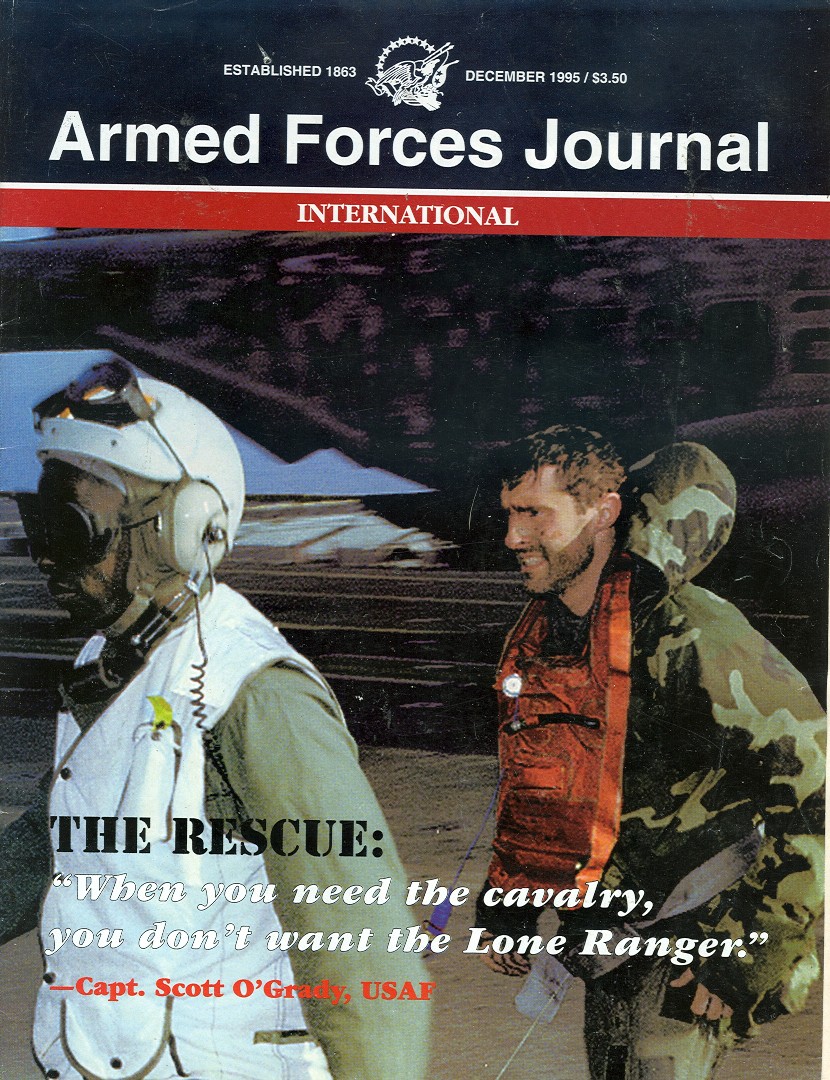

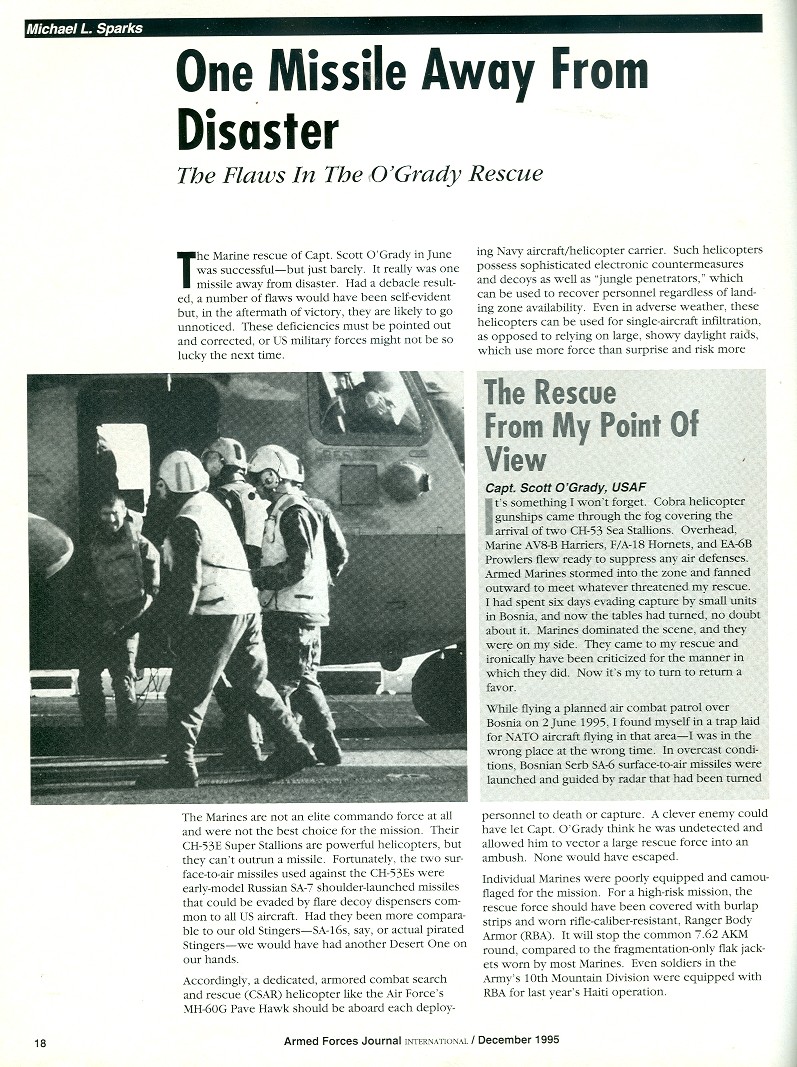
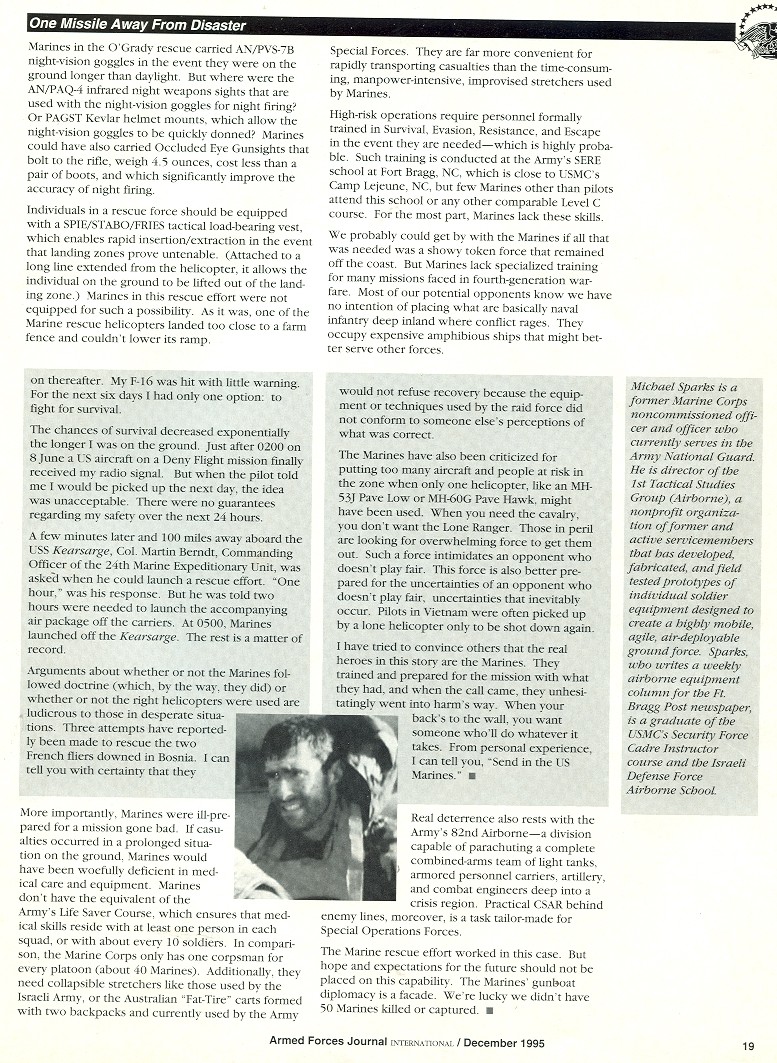
Miles from the nearest U.N. protected city, deep in war-torn Bosnia, Captain Scott O'Grady, U.S. Air Force, is running and hiding for his life pursued by Bosnian infantrymen scouring the countryside. 8 days before, the Serbs had shot down him and his F-16C "Fighting Falcon" jet in an airborne equivalent of an ambush. Ejecting, then parachuting from high altitude to the ground and hanging under canopy for several minutes, Cpt. O'Grady was out of his harness just seconds before the Serbs arrived at his crash site. Now, days later, out of water, living on whatever plants and insects he can find, he's at his "wit's end". Meanwhile, millions of dollars of sophisticated U.S. electronic means can neither locate Cpt. O'Grady, nor keep track of the hundreds of Serbian soldiers searching the area for him. Miraculously, a pilot in his squadron flies overhead on patrol and O'Grady contacts him by emergency radio: helicopters will be on the way to rescue him.
But Cpt. O'Grady has yet another problem; he doesn't have a "PATHFINDER"-a skilled individual or team of soldiers trained to guide in the helicopters or measure and mark the cow pasture he's nearby to make it suitable for landing (a "landing zone") at night. So instead of sending the single night-sensor equipped USAF helicopter already on alert from Italy immediately under the cover of night, the U.S. Navy commander in charge, decides to wait keeping O'Grady in grave danger and gamble on a large-scale, daylight rescue mission without checking the landing area, in order to garner the credit to the Navy-marine corps.
Cpt. O'Grady moves to the open pasture area and hopes the Serbs are not lying nearby in ambush using him as "bait" as the enemy often did in the Vietnam War. As the pair of CH-53E Super Stallion helicopters rumble towards him, a smoke device billows up into the air beckoning in the large helicopters to land crammed with full loads of young marines, some just out of high school and basic training. The unsurveyed landing site has a farm fence that jams the rear ramp of one of the CH-53Es so it cannot open, trapping all the marines inside. An oddly dressed man darts from the wood line towards the boxed-in helicopter; fortunately the smoke signal wasn't from a Serbian ground ambush; its Cpt. O'Grady.
The ground force commander in the helicopter loads Cpt. O'Grady through the crew chief hatch, feeds him an MRE (Meal-to-Ready-to-Eat) and the rescue flight takes off for the coast. Two Serbian surface-to-air missiles and small arms are fired at the large helicopters skimming the treetops; providentially, they return to their Navy ship with just bullet holes; a close call that almost ended in fiery tragedy re: "One Missile Away from Disaster" see December 1995 Armed Forces Journal article above. O'Grady is a victim overcome that he is alive. His words are from tactical ignorance; in Vietnam large clusterfucks of helicopters insured some WOULD GET SHOT-DOWN. He should go to a library and read about the BAT-21 debacle before trying to use his victim status to distort the development of sound military practices.
www.youtube.com/watch?v=402XdSKkSGo
One of the many lessons of the O'Grady rescue is the need for trained men on the ground to verify that the landing zone is secure, without obstacles; who can control a landing flight of helicopters so they can touch down quickly-not linger... and get out of the open danger area where they are very vulnerable to enemy fire. Even sophisticated stand-off electronic means have proved unable to completely verify the location of troops, landmines, anti-aircraft guns and missiles that are expertly camouflaged. Launching an air strike or artillery barrage on O'Grady's cow pasture to clear it of enemy mines/forces would have alerted the Serbs and threatened O'Grady himself. Had this been full-scale war with the U.S. wanting to insert/extract a major fighting force by helicopter or fixed wing aircraft parachute assault and not a single downed aviator, we clearly would need another option other than uncertain gambles that have cost the lives of men and millions of dollars of aircraft/equipment in the past.
That option to secure and control Drop-Landing Zones is the U.S. Army PATHFINDER.
U.S. Army PATHFINDERS were created at the dawn of troop vertical insertion tactics; in World War II, U.S. Army Airborne units were dropped into the island of Sicily but scattered badly when their C-47s flown by inexperienced pilots couldn't locate their drop zones in the dark. Shortly thereafter, Colonel (later General) James M. Gavin the legendary 82nd Airborne's Regimental and Division Commander selected a small group of elite paratroopers from the 504th and 505th Parachute Infantry Regiments to jump in first to mark the drop zones with coded lights and guide troop carrying aircraft by radio beacons were selected: PATHFINDERS. WWII PATHFINDERS
A Scout Section in the 509th Parachute Infantry Regiment also formed a provisional PATHFINDER unit. Months later, 50 PATHFINDERS jumped in first to guide the 504th and 505th PIR into their successful jumps into the Salerno beachead in 1943. This flawless delivery of paratroops into the beleaguered beaches turned the tide of battle as the Germans were pushed away by determined paratrooper attacks.
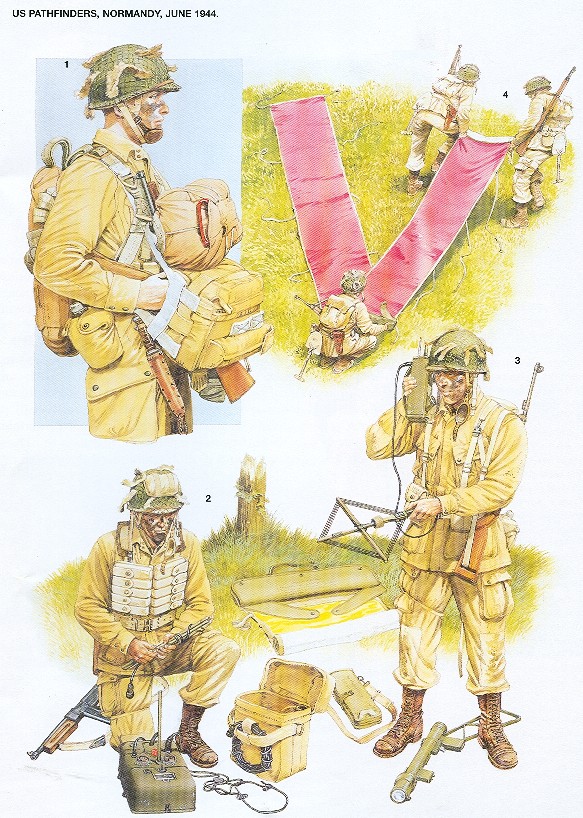
PATHFINDERS jumped first into Normandy on D-Day, June 6, 1944 in the hours of darkness to guide in the 82nd and 101st U.S. and 6th British Airborne Divisions of paratroopers; the critical forces that held off fierce German counter-attacks so the sea-borne invasion force could get established at daybreak. Jumping into Normandy
Once ashore, the U.S. Army, British and Canadian Armies didn't stop until the Germans were defeated in 1945. Leading them across Europe were their Airborne and Armored Divisions, the former guided accurately to their drop zones by PATHFINDERS.
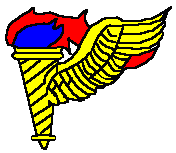 The PATHFINDER's distinctive winged torch symbol comes from ancient Greece where runners opened up the Olympic Games and means to "Light the Way". The original red backing worn on PATHFINDERS from 1943 onwards was changed to black in 1964 to signify night operations. PATHFINDERS wear the full-color winged torch on their Class "A" uniforms and a subdued version on their Battle-Dress Uniforms (BDUs) and now Army Combat Uniforms (ACUs).
The PATHFINDER's distinctive winged torch symbol comes from ancient Greece where runners opened up the Olympic Games and means to "Light the Way". The original red backing worn on PATHFINDERS from 1943 onwards was changed to black in 1964 to signify night operations. PATHFINDERS wear the full-color winged torch on their Class "A" uniforms and a subdued version on their Battle-Dress Uniforms (BDUs) and now Army Combat Uniforms (ACUs).
U.S. Army PATHFINDERS are trained and qualified at their school and at the myriad drop and landing zones of Fort Benning, Georgia. Created after the war, by veterans of the WWII Pathfinder jumps to lead the Normandy invasion, U.S. Army PATHFINDER school serves as the focal point for PATHFINDERS, old and new. The main classroom, is named after Roland J. Duff who jumped into Normandy as a PATHFINDER in 1944 and later jumped again into South France for the 50th Anniversary D-Day celebration in 1994! Normandy jump '95
The hallmark of U.S. Army PATHFINDERS has been their toughness coupled with intellect. The school building located across from Mann Field's towers and Airborne training equipment has its halls lined with some very innovative plaques left by graduating classes of PATHFINDERS and jumpmaster classes who share the building. Both courses go "hand-in-hand" to form the Advanced Airborne School of the 1-507th PIR (ABN).
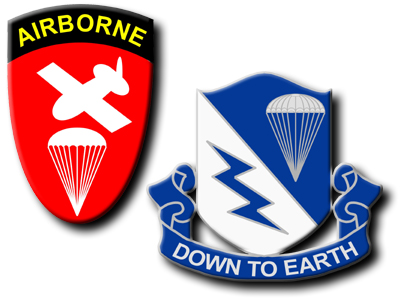 PATHFINDER School was the leading proponent of changes to improve the control of Airborne operations during the critical post-WWII years. The "Eureka" beacons jumped into Normandy were heavy and unreliable; 2 were jumped to provide back-up. A coded radio signal was sent out when the aircraft were about 25 miles away; this was received inside lead aircraft with "Rebecca" sets who got a directional fix to steer towards the DZ. Once the aircraft were in sight over the DZ, the Eureka beacon was turned off since visual signals on the ground could then be used for accurate release points for paratroops to jump. PATHFINDERS experimented with bulky radio beacons during numerous tactical jumps, refining the equipment to today's rugged, compact jam-resistant beacons and and infared lights visible only by night vision goggle-equipped pilots.
PATHFINDER School was the leading proponent of changes to improve the control of Airborne operations during the critical post-WWII years. The "Eureka" beacons jumped into Normandy were heavy and unreliable; 2 were jumped to provide back-up. A coded radio signal was sent out when the aircraft were about 25 miles away; this was received inside lead aircraft with "Rebecca" sets who got a directional fix to steer towards the DZ. Once the aircraft were in sight over the DZ, the Eureka beacon was turned off since visual signals on the ground could then be used for accurate release points for paratroops to jump. PATHFINDERS experimented with bulky radio beacons during numerous tactical jumps, refining the equipment to today's rugged, compact jam-resistant beacons and and infared lights visible only by night vision goggle-equipped pilots.
As helicopter aviation matured, the selection, survey and control of Landing Zones became an added responsibility for PATHFINDERS. Landing Zone and Drop Zone control was critical to battlefield troop movement and resupply; winning several battles and saving thousands of U.S. Soldier lives by timely MEDEVAC during the Korean and Vietnam wars. However, time and time again whenever PATHFINDER type advance survey/control was overlooked, troop casualties and aircraft losses ensued. For example; the marine-misled USAF helicopter landings on heavily defended and fortified Cambodian Koh Tang island beaches not "reconned" by PATHFINDERS to search for the kidnapped crew of the U.S. container ship, SS. Mayaguez (unlike the O'Grady rescue), did end in fiery tragedy in 1975. At Desert One in 1980, the Iran Rescue mission ended in a mess due to marines flying unfamiliar Navy helicopters with unclear ground control. For aerial troop delivery tactics to work, their aircraft cannot afford to fly into and linger on heavily defended drop or landing zones.
Lessons learned from these conflicts were later incorporated by the U.S. Army's Rangers and 82nd Airborne Division for the former's dawn jump at 500 feet into Point Salines Airfield on the island of Grenada in 1983 and both unit's successful night combat jumps into Panama in 1989. After securing the airfields in Panama, paratroopers made the follow-on helicopter air assaults to destroy & secure key targets of the Panamanian Defense Forces. PATHFINDER qualified Army personnel were integral to this success by planning and executing these airborne assaults.
A dedicated PATHFINDER company assigned to the helicopter-mobile, 101st Airborne Division at Fort Campbell, Kentucky lead that division on the largest and deepest Air Assault in military history to secure the left flank of the "Hail Mary" left envelopment of Operation Desert Storm in 1991. Little known, but highly critical to the success of the Gulf War against Iraq were the PATHFINDERs who placed dozens of beacons into enemy-held territory to guide in the waves of attack aircraft to make the "Air War" possible.
 Today, a well-camouflaged PATHFINDER-qualified team clandestinely infiltrated to secure drop and landing zones for follow-on troops is a proven and sound "investment" that will continue to increase in importance as the increasingly sensor swept battlefield makes it ever more difficult to achieve surprise. "Thellie" camouflage suits can render PATHFINDERs invisible to even detection from their body heatTeledyne Brown Engineering and folding "Mountain" bikes under development by U.S. Army Natick labs can help speed them to their intended DZ-LZs quietly from a safe, discreet stand-off distance to avoid enemy detection. ATBs
Today, a well-camouflaged PATHFINDER-qualified team clandestinely infiltrated to secure drop and landing zones for follow-on troops is a proven and sound "investment" that will continue to increase in importance as the increasingly sensor swept battlefield makes it ever more difficult to achieve surprise. "Thellie" camouflage suits can render PATHFINDERs invisible to even detection from their body heatTeledyne Brown Engineering and folding "Mountain" bikes under development by U.S. Army Natick labs can help speed them to their intended DZ-LZs quietly from a safe, discreet stand-off distance to avoid enemy detection. ATBs
"Blasting to bits" a drop and landing zone may sweep them clear of some mines, obstacles and enemy forces, but surprise will have been lost for follow-on missions. Aircraft will have to continue to get quieter and more "stealthy". One way is to HOVER and have the PATHFINDER team fast rope into and out of a distant small terrain opening which can be almost anywhere using the Fast Rope Insertion/Extraction System (FRIES) or rappelling...


PATHFINDERS will spearhead this effort; a team in hiding, providing continuous "eyes on" using sensors like thermal viewers to detect possible enemy mines, warning devices and to clandestinely survey the DZ-LZ for days and hours ahead of the mission is still the most reliable "surveillance system" and should always be a capability in our "box of tools" even if remote sensing from unmanned platforms develop into viable options. A PATHFINDER team can insure the DZ/LZ is large enough and clear of obstacles to maximize the speedy delivery of troops, equipment and fighting vehicles in the best formation possible. Clandestine signals like the new VS-21 Basic Marker InfaRed (BMIR) panel can be seen only through friendly passive infared devices so troop insertion surprise and shock action can be preserved. Time is critical on the non-linear battlefield.
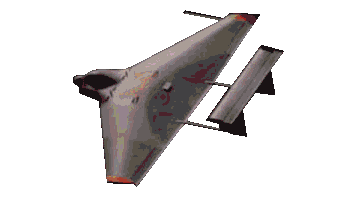
If we were to rely solely on machines for our reconnaissance, tactical human intelligence (HUMINT) gathering skills that take years to perfect will be lost. Unmanned Aerial Vehicle (UAV) overflight might compromise the mission by alerting the enemy to lie in ambush as what befell IDF Naval Flotilla 13 Commandos on September 5, 1997 Raid Analysis If electronic devices fail to give us a reliable, accurate picture, there may be insufficient or no Soldiers at all trained to operate alone in denied areas that can survey a DZ-LZ available to turn to for DZ-LZ HUMINT unless we forge ahead with human PATHFINDER innovations.
U.S. Army PATHFINDER School is 3 weeks long, beginning with Medical Evacuation procedures and helicopter configurations, to include the use of Stokes and SKEDCO litter systems SKEDCO and Oregon Spine Splint Air Traffic Control and helicopter sling loading procedures culminate in an extremely difficult hands-on test inspecting helicopter external sling loads for minute rigging errors that could result in the load being damaged/lost or potentially an aircraft accident. If you refer to early editions of FM 57-38 PATHFINDER Operations in the Infantry Hall Building 4 Donovan Technical Library, pre-dating the current 1993 edition handed out to PATHFINDER students, you'll note how helicopter procedures and expertise has steadily improved with each manual.

Those that pass the test or retest successfully on the sling-loads then prepare to move out to the field to set-up a helicopter landing site (HLS); first led by the cadre themselves, then the students. The small PATHFINDER class of about 40-50 soldiers is broken down into 2 sections of 20-25 led by 3 instructors per section. After the hands-on practice in the field, the students take a written test on HLS procedures. Attending PATHFINDER class 8-97 is SSG Anthony Campos, an Air Assault and rappel master qualified expert medic who flies on board Fort Benning's 498th Aeromedical Evacuation (Air Ambulance) Company's UH-60 Blackhawk helicopters.
He spoke of the sling-load test: "The sling-load test was a scorcher.....Fortunately I had already been through Air Assault School so I was already familiar with sling-loads, so I passed with a first-time 'go'. If you haven't been to Air Assault School when you go to PATHFINDER school make sure you read over FM 57-38 Pathfinder Operations."
The next day's classes focus on survey, marking and control of Drop Zones (DZs) and wind measurements. After being trained in aircraft and air traffic control (ATC) procedures, the PATHFINDER students go to Fryer Drop Zone to learn how by watching the PATHFINDER cadre control an actual drop of paratroopers from both an U.S. Army UH-60 Blackhawk helicopter and a USAF C-130 Hercules transport. PATHFINDER students that are Airborne qualified go through jump refresher and jump with the cadre to provide paratroops for their classmates on the ground to see being controlled by the PATHFINDER cadre on the ground for the proper positioning/timing to exit the aircraft.
Once students who jumped turn in their air items, they practice paratrooper release procedures using the Verbally Initiated Release System or (VIRS) while the Blackhawks make "dry run" passes overhead. VIRS is primarily used for placing small units into very small drop zones. PATHFINDER students learn the mathematical computations necessary to determine the exact placement of markers on the ground so paratroopers and/or equipment bundles descend to the correct spot on large drop zones for another air-delivery technique; the Ground Marked Release System (GMRS). They learn how to measure the wind speed and direction to determine if the conditions are safe for a parachute jump. The written exam on drop zones is a key challenge for many to pass. Everyone in PATHFINDER Class 8-97 made it through the Drop Zone exam challenge.

Next, the class assembles into helicopter chalks and flies out to a helicopter landing site (HLS) for survey and marking for a 2-day tactical field exercise. The students will actually sling-load and hook-up a HMMWV 4X4 truck, water buffalo, ammo boxes in cargo netting, a fuel blivet and field expedient loads for CH-47D Chinook helicopters during the daytime and night. The actual helicopter route, and air movement and loading tables are planned by students acting as a 12-man team led by a student Team Leader and Assistant Team Leader. The Team Leader gives a full Operations Order briefed on a terrain model prepared by the remaining students.
Helping their peers for the mission are a GTA (Ground-to-Air) who has the "master map" marked with the control zone, Communications CheckPoint-CCP, Reference Points and ATC information. An RTO (Radio Telephone Operator) with AN/PRC-119 SINCGARS FM radio which communicates with inbound aircraft the moment they fly over the CCP and switch over to FM, an INR (Internal Net Recorder) who serves as a back-up GTA and records all landings and departures, a Sling Load Team with Leader, hook-up and static probe discharge men to connect external loads to hovering helicopters. Other key duties within the HLS Survey are the Signalmen with light wands and colored gloves and the Marking Party (those not in a team assignment) which is led by the Assistant Team Leader in these graded, "hands-on" exercises.
After the final examination covering all areas, those that pass are awarded the coveted "Flaming Torch" badge of the U.S. Army PATHFINDER. These soldiers and members of other services then go back to their units, providing them at least one qualified specialist that can lead PATHFINDER operations for them if they execute air movement. This body of expertise spread throughout the Army needs to be expanded since any U.S. Army unit can with little or no warning be tasked to take part in a helicopter movement for the troops themselves to load/unload a helicopter requires only a few hours of training-the hardest task is getting them to a secure, suitable LZ; for that U.S. Army PATHFINDERS show the way. Their motto; "Semper Primus" or "Always First" has been the watchword of warriors whose skills when used in the past have brought us success and serves as our guide to the future.
AIRBORNE!
For more on the History of the PATHFINDERS or U.S. AIRBORNE: U.S. Airborne Virtual Museum
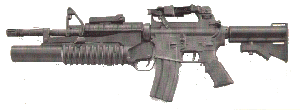 To return
to PARATROOPER 2000 click on the M4 5.56mm Carbine with M203 40mm grenade launcher......
To return
to PARATROOPER 2000 click on the M4 5.56mm Carbine with M203 40mm grenade launcher......
 To return
to 1st Tactical Studies Group (Airborne) home pages click on the U.S. Army Airborne wings...
To return
to 1st Tactical Studies Group (Airborne) home pages click on the U.S. Army Airborne wings...